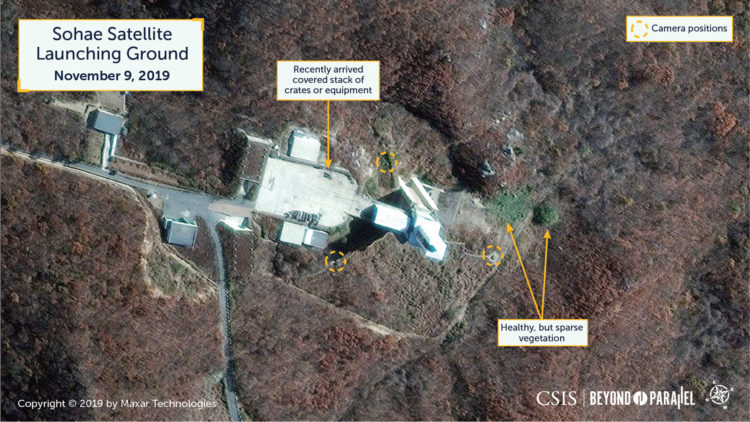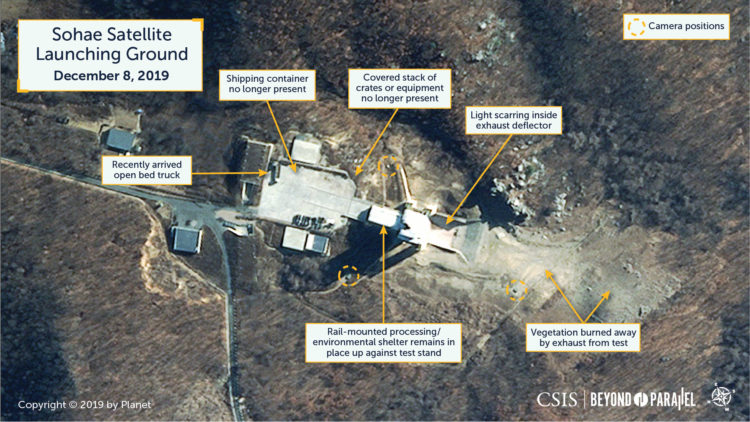
Sohae Engine Test Part of Coercive Diplomacy Tactic as End-of-Year Deadline Approaches
Key Findings
- North Korea tested a liquid-fuel rocket engine at the vertical engine test stand at Sohae on December 7, 2019.
- This was a successful test, aside from DPRK statements to that effect, as indicated by there being no visible damage observed to the engine test stand and vegetation burned-off at the exit of the stand’s exhaust deflector.
- North Korea minimized visual indicators of a test purposefully seeking to surprise the Trump administration, as part of a diplomatic pressure strategy to elicit concessions on sanctions before Kim Jong-un’s self-declared diplomacy deadline of the end of the year.
- Other upcoming demonstrations are possible such as a nuclear test, SLBM demonstration, or a solid fuel rocket motor test.
- The latter do not usually take place at Sohae. They are tested at the Magunpo Solid Rocket Motor Test Facility on the east coast and elsewhere.
- The series of images in this report show the progression of preparations that have been made since November and the facility as seen on December 8 following the test.

On December 7, North Korea conducted what it described as a “…very important test at the Sohae Satellite Launching Ground.” Satellite imagery in the days leading up to and after the test clearly shows that this was a rocket engine test at the vertical engine test stand at Sohae. This test was most probably of a liquid-fuel rocket engine as only liquid-fuel rocket engines have previously been tested here, while large solid rocket motors have been tested at the Magunpo Solid Rocket Motor Test Facility on the east coast and elsewhere. Whether the liquid-fuel rocket engine was an existing model or a new one is unknown.
While the test was undoubtedly of importance to North Korea’s ballistic missile program it was more significantly an expression of a broader long-term international diplomatic strategy to increase political pressure on the United States to acquiesce to North Korea’s demands. This is indicated by North Korea’s escalating statements leading up to the test, the date chosen for the test (Pearl Harbor Day in the United States), and North Korean statements following the test.
As is clear to most North Korea analysts or observers, the North is very well aware of the use of commercial satellite imagery to provide insight into their nation, especially their WMD and military programs. Because of this they have over the past 10 years continued to evolve procedures to either mask their intentions or to telegraph messages in a manner of their choosing in the international press.
Satellite imagery during the past two months provides us with some insights into how North Korea minimized their previously established test preparation procedures for this test event. These developments may provide insight into how the North will approach future test preparations here at Sohae and elsewhere.
Following the abortive February 2019 U.S.-North Korea Hanoi Summit, North Korea undertook the reassembling of the rocket engine test at Sohae.1 At this time, they also moved the rail-mounted processing/environmental shelter up against the test stand. Previously, it remained on the main concrete pad until a rocket engine arrived and was prepared for testing. Only then would the shelter with engine be moved up to the test stand and the engine mounted. This process typically took two to four weeks and was accompanied by an increase in vehicle traffic in the test stand area and at the administrative and security headquarters near the entrance to the facility – all of which were clearly identifiable in satellite imagery.
This time, with the rail-mounted processing/environmental shelter already in place adjacent to the test stand and carefully limiting vehicle movements to periods when commercial satellites were not generally available to collect, the North was able to minimize much of the visual indicators of engine test preparations.
Since early summer the vertical engine test stand remained essentially unchanged and as it appeared in a November 1st satellite imagery. In retrospect the first probable indicator of preparations for the recent rocket engine test was the arrival of a tarp-covered collection of crates/equipment on the main concrete pad first identified on November 9th. A month later, on December 4th, this collection of crates/equipment had either been moved closer to the test stand or a new collection of crates/equipment had arrived and been placed there. By themselves, either of these actions could have equally been for routine maintenance or preparations for a new engine test. Otherwise, there were no indications of preparations for a new engine test at the test stand or elsewhere in the facility. The following day, the 5th, however, two images were collected—one at 11:23 AM (local time) and the second at 2:27 PM (local time). While the first was essentially identical to the previous day’s image, the second showed the presence of what appears to be a blue shipping container approximately 10-meters-by-2.3-meters and was a strong, but not conclusive, indicator of an imminent engine test. That this shipping container was no longer present on the 6th lent weight to suspicions that an engine test was imminent. Imagery from early afternoon on the 7th shows that the collection of crates/equipment was no longer present and several small vehicles (one of which may have been a van) were now present. Later that day the North conducted the engine test. Imagery from the 8th indicates that the test was successful as there was no visible damage observed to the engine test stand and vegetation was burned-off at the exit of the stand’s exhaust deflector.

A tarp-covered collection of crates/equipment can be seen on the main concrete pad as of November 9. (Copyright © 2019 by Maxar Technologies) 
The crates/equipment seen in the November 9 image have been moved closer to the test stand or a new collection of crates/equipment have been placed near the test stand as of December 4. (Copyright © 2019 by Airbus) 
Between 11:23 PM and 2:27 PM local time on December 5, a blue shipping container measuring approximately 10-meters-by-2.3-meters arrived at the facility. (Copyright © 2019 by Planet)
While the length of preparations for the engine test – approximately four weeks – appears to fall within the range that had been previously observed, the observable indications had been significantly reduced. Exactly why it was decided to change the pattern at this point is unclear. It may simply be part of evolving North Korean camouflage, concealment and deception (CCD) practices. It, however, could be part of a broader long-term North Korean negotiating strategy that seeks to keep analysts and observers speculating longer about its ballistic capabilities. Thereby, increasing world media coverage and attempting to control the messaging of a diplomatically important but technically routine event when it did occur.

References
- The test stand had been disassembled, but not disabled, following the June 2018 U.S.-North Korea Singapore Summit ↩
